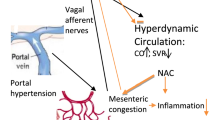Abstract
Increased susceptibility to mucosal damage is a prominent feature of portal hypertensive gastropathy. Since the portal hypertensive gastric mucosa has extensive microvascular changes, we postulated that the increased sensitivity to mucosal damage could have an ischemic basis. We measured distribution of gastric serosal and mucosal oxygenation in a group of portal hypertensive and sham-operated rats, and then studied the effects of intragastric aspirin. In the basal state, gastric mucosa of portal hypertensive rats had significantly reduced oxygenation compared to controls (24±5 vs 45±7 mm Hg PO 2,P < 0.02), while serosal oxygenation was similar between the two groups. Intragastric aspirin produced significantly greater mucosal damage to portal hypertensive rats and mucosal oxygenation was almost one third that of sham-operated controls. Systemic arterial pressures and oxygenation were similar between the two groups. We conclude that there is impairment of gastric mucosal oxygenation and increased mucosal damage by aspirin in portal hypertensive rats compared with sham-operated controls. These results support our hypothesis that the increased sensitivity of the portal hypertensive mucosa to damage is a consequence of impaired mucosal oxygenation.
Similar content being viewed by others
References
Sarfeh IJ, Tarnawski A, Maeda R, Raymont K, Mason GR, Ivey KJ: The gastric mucosa in portal hypertension: Effects of topical bile acid. Scand J Gastroenterol 19(suppl 92):189–194, 1984
Sarfeh IJ, Malki A, Tarnawski A, Ivey KJ, Mason GR: Portal hypertension and gastric mucosal injury in rats: Effects of alcohol. Gastroenterology 84:987–993, 1983
Maeda R, Guilmette E, Tarnawski A, Sarfeh IJ: Bile acid-induced gastric mucosal injury: Significance of portal hypertension and mucosal capillary permeability. J Surg Res 36:312–314, 1984
McCormack TT, Sims J, Eyre-Brook I, Kennedy H, Goepel J: Gastric lesions in portal hypertension: Inflammatory or congestive gastropathy? Gut 26:1226–1232, 1985
Tarnawski A, Sarfeh IJ, Stachura J, Hajduczek A, Bui HX: Portal hypertensive gastropathy or vasculopathy? Gastroenterology 92:1786, 1987 (abstract)
Hashizume M, Tanaka K, Inokuchi K: Morphology of gastric microcirculation in cirrhosis. Hepatology 3 1008–1012, 1983
Manabe T, Suzuki T, Honjo I: Changes of gastric blood flow in experimentally induced cirrhosis of the liver. Surg Obstet Gynecol 147:753–757, 1978
Vorobioff J, Bredfeldt JE, Groszmann RJ: Hyperdynamic circulation in the portal hypertensive rat model: A primary factor for maintenance of chronic portal hypertension. Am J Physiol 244:G52-G57, 1983
Applebaum R, Bowman R, Tremper KK, Shoemaker WC: Emergency Pao2 estimates in one minute with a transcutaneous oxygen sensor. Crit Care Med 9:742–745, 1981
Kram HB, Shoemaker WC: Method for intraoperative assessment of organ perfusion and viability using a miniature oxygen sensor. Am J Surg 148:404–409, 1984
Sankary HN, Waxman K, Rypins EB, Tremper K, Sarfeh IJ: Effects of portacaval shunt and hepatic artery ligation on liver surface oxygen tension and effective hepatic blood flow. J Surg Res 42:7–9, 1987
Sheridan WG, Lowndes R, Young HL: Tissue oxygen tension measurement in the human gastrointestinal tract. Gut 27:A1255-A1256, 1986
Tominaga G, Waxman K, Soliman MH, Sarfeh IJ, Bui HX, Tarnawski A: Protective effect of pentoxifylline on gastric mucosa. J Surg Res 44:727–732, 1988
Sarfeh IJ, Tarnawski A, Hajduczek J, et al: Does portal hypertension predispose gastric mucosa to aspirin injury? Histological, ultrastructural and functional analysis. Gastroenterology 92:1614, 1987 (abstract)
Yeomans ND, Yolin DJB, de Broer WG: Regeneration of gastric mucosa after aspirin induced injury in the rat. Dig Dis Sci 18:773–780, 1978
Tarnawski A, Hollander D, Stachura J, Kraus WJ: Can arachidonic acid (prostaglandin precursor) protect the gastric mucosa against aspirin injury? Macroscopic, ultrastructural and functional time sequence analysis. Gastroenterology 92:1786, 1987 (abstract)
Guth PH, Paulsen GM, Nagata H: Histologic and microcirculatory changes in alcohol-induced gastric lesions in the rat: Effects of prostaglandin cytoprotection. Gastroenterology 37:1083–1090, 1984
Author information
Authors and Affiliations
Additional information
This study was supported by the Veterans Administration Research Service.
Rights and permissions
About this article
Cite this article
Sarfeh, I.J., Soliman, H., Waxman, K. et al. Impaired oxygenation of gastric mucosa in portal hypertension. Digest Dis Sci 34, 225–228 (1989). https://doi.org/10.1007/BF01536055
Received:
Revised:
Accepted:
Issue Date:
DOI: https://doi.org/10.1007/BF01536055




